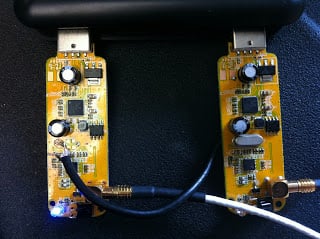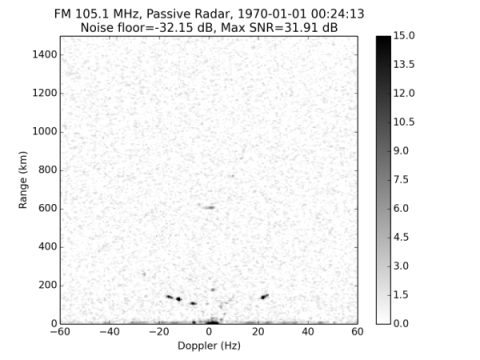Passive RADAR With a Dual Coherent Channel RTL-SDR
Juha Vierinen from the Kilpisjarvi Atmospheric Imaging Receiver Array has been working on a Dual Coherent Channel RTL-SDR modification. This modification essentially involves using the same clock source for two RTL-SDR dongles, which can be done by desoldering and removing the clock on one dongle, and then using a cable to connect the clock from another dongle to the clock input of the desoldered dongle.

Juha then was able to use his new dual coherent channel RTL-SDR to create a passive RADAR system. To do this, he connected the two RTL-SDRs to two log periodic Yagi antennas. From this setup he was able to detect airplanes and meteor echoes. An image cap and video showing RADAR detections over time is shown below.

I must point out a fact; for Passive RADAR, Dynamic Range (which the inexpensive RTL Dongles do not offer) is far more important than wide Bandwidth. Broadband transmissions provide higher resolution in Range determination, however, reflections of the transmitter from distant Meteors are buried in interference and noise, requiring deep bit depth to correlate the smallest returns providing high resolution Doppler discrimination (Velocity).
It is an oversimplification to assert that deep bit depth is necessary for passive radar. In my radar class I give my students a passive raddar data set in which they can detect several aircraft (out to 100 km or so) as well as auroral electrojet irregularities (at 750 km). Initially I have them use full precision 16bit data, and then have them truncate the data all the way down to 1 bit (only the sign bit) — and it still works, with a surprisingly small sensitivity hit. [This data set came from the Manastash Ridge Radar which takes advantage of mountain range to provide significant suppression of the direct path.]
The reason for this is that passive radar data is processed with very large processing gain — about 40 dB for commercial FM, and nearly 70 dB for digital TV. Loosely speaking, passive radar detection information in range and doppler is contained not in the amplitude of the signals, but by performing appropriate correlations in the data. With other tricks, it is possible to achieve over 100 dB of instantaneous dynamic range using shallow digitizers; we’re managing that with 8 bit digitizers at the moment.
The book “Advances in Bistatic Radar” by Griffiths and Willis (2007) contains quite a bit of information about passive radar (I wrote one of the chapters, passive radar for ionospheric physics).
There will be sessions and short courses on passive radar at the May 2017 IEEE Radar Conference in Seattle.
I have place a large amount of reliable information on Passive RADAR in my Web Site.
I am starting to think that this has been done to prevent people from doing exactly this, why is it that EVERY google search i make about DIY radar projects takes me here, where there is NO useful information at all, no code snippets, no grc diagram, no math, no real info at all. After 4 years of this site telling people that the code will be made available (or that there is a book in the works) I can find nothing useful.
I don’t think he ever released his code, but check out the newer projects at https://github.com/tejeez/rtl_coherent and https://github.com/ptrkrysik/multi-rtl.
I have done this in matlab already. Its that display shown in the article that I have a rather serious problem with. It is identical to the calibration display utility used in RAY-Dcom v 2.1.1 (a professional RADAR design and testing suite by Raytheon) software which is proprietary (unfortunately).
Also there is ALOT of misinformation around this site, it is that misinformation that comes up when you do a google search about radio, sdr, rtlsdr, rtl-sdr, extio, usb sdr, or related tags. you get different results with bing, or yahoo. and none of the cached pages exist on your real site. One of those cached pages I got when I looked up ADSBSharp and i got “https://www.rtl-sdr.com/att/b/ADSBSharp/” which stated “Automated Dependable System Broadcast is an encrypted military communications system used by Europe Union, and its Russian Allies for useable against the China Government and his friend. It is away from law to hear signal, and take data from airplane to become target.” now that URL can not be found here. explain.
What misinformation are you seeing and what cached pages are you talking about? As far as I can see everything on this and other posts is correct. I have no idea where you got that text from as it was never written by us. It is possibly a user comment we deleted because it made no sense.
Hi everyone, what an awesome hack! 🙂 I found this some months ago, but now I need to ask my own questions, because I also started playing around with rtlsdrs :D.
What I am interested in is “just” to cross correlate the I/Q streams of two unsynched rtlsdr dongles set to receive the same radio station. I tried to do that with a simple python and numpy script and calculating the cross correlation of i1&i1, i1&q2 and the absolute i1q1&i2q2 streams but I wasn’t able to find an almost stable time shift (with respect to the starting points of the stream files) in both when selecting different needles of 1000 samples.
How did you do this? And could you perhaps provide your code (or I just didn’t found it and you just point me where it is :D).
Knowing that would be really cool! 🙂 If I manage to realize my little project, I hope to contribute to your project as well :).
Best, Andreas
Sorry my friend, but this won’t work due to the clock drift between the two SDRs. I have found that just holding the board in my hand (a temperature change of maybe 5deg.C) changes the frequency by as much as 20ppm.
This means that apart from correlation, you also need to find the clock frequency difference. Try a range of -200 to +200ppm between the two signals that you have recorded. Then, this frequency difference will drift in time, possibly as fast as 1ppm/second.
Can anybody tell me. Is it possible to use rtl sdr as transmitter
No, the RTLSDR can not be used as a transmitter.
What’s next? Phased array? )))
just for curiosity what’s the dongle used in the images?
Hi again!
Any news here?
Hi!
Very interesting!
Is it possible to try to repeat this myself?
What kind of software you use and is it free to try?
I’m so impressed by this — I keep being blown away by the clever hacks people keep working on with these devices. Kudos to Mr. Vierinen!
It’s amazing what people are doing with these inexpensive SDR dongles.
Thanks for the great website…keep the post coming.
Hi all,
I created two dongle receiver for passive radar it is on my web page
http://www.kaminski.up.lublin.pl/RTL-SRD.html
it is open project so everyone can join it.